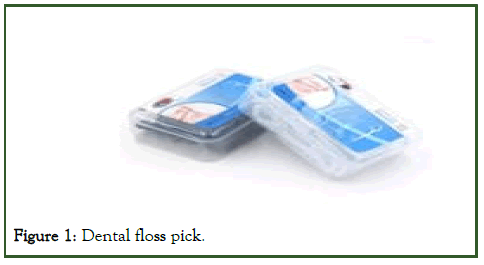Citations : 2345
Dentistry received 2345 citations as per Google Scholar report
Indexed In
- Genamics JournalSeek
- JournalTOCs
- CiteFactor
- Ulrich's Periodicals Directory
- RefSeek
- Hamdard University
- EBSCO A-Z
- Directory of Abstract Indexing for Journals
- OCLC- WorldCat
- Publons
- Geneva Foundation for Medical Education and Research
- Euro Pub
- Google Scholar
Useful Links
Share This Page
Journal Flyer

Open Access Journals
- Agri and Aquaculture
- Biochemistry
- Bioinformatics & Systems Biology
- Business & Management
- Chemistry
- Clinical Sciences
- Engineering
- Food & Nutrition
- General Science
- Genetics & Molecular Biology
- Immunology & Microbiology
- Medical Sciences
- Neuroscience & Psychology
- Nursing & Health Care
- Pharmaceutical Sciences
Short Communication - (2024) Volume 14, Issue 3
How to Select Dental Floss
Adam Zhang*Received: 18-Aug-2021, Manuscript No. DCR-24-12420; Editor assigned: 23-Aug-2021, Pre QC No. DCR-24-12420 (PQ); Reviewed: 06-Sep-2021, QC No. DCR-24-12420; Revised: 02-Sep-2024, Manuscript No. DCR-24-12420 (R); Published: 30-Sep-2024, DOI: 10.35248/2161-1122.24.14.702
Introduction
Some people have a good oral health awareness. They use floss to clean their teeth every day after meals, so here are some questions for the materials and classification of the floss for those who are concerned about dental floss [1]. In terms of materials, the mainstream dental floss in the market is basically divided into five materials: Nylon (polyamide fiber), polyester (polyester fiber), polymer (UHMWPE), bamboo charcoal fiber and teflon (polytetrafluoroethylene).
Description
Nylon (polyamide fiber)
It is superior to other fibers in abrasion resistance, good in elasticity, light in weight, corrosion-resistant, not afraid of insects, not afraid of mold and smooth surface and has a waxy feel, mainly used for leather sewing [2].
The disadvantage is that the optical rotation resistance is poor and it will become yellow and the strength is lowered if it is exposed to the sun for a long time.
Polyester (polyester fiber)
It has excellent styling properties. The polyester yarn or fabric has a flat and fluffy shape after being shaped and it can be used for a long time after repeated washing in use.
The fiber is simple in production process, low in price, good in light resistance, strong in durability, good in elasticity, not easy to be deformed and resistant to corrosion [3]. In terms of performance alone, it is sufficient for the floss thrown away after using.
Polymer floss (UHMWPE) Ultra High Molecular Weight Polyethylene
It has unmatched wear resistance, impact resistance, corrosion resistance, water absorption impact energy, low temperature resistance, hygienic disinfection, non-sticking and easy to be used in ordinary polyethylene and other engineering plastics. Water absorption, low density performance [4]. Therefore, the floss made of this material has strong pulling force, high wear resistance coefficient and is not easy to break the wire.
Bamboo charcoal fiber
It is the most popular material in the 21st century and is known as the “new guardian of environmental protection in the 21st century”. Bamboo charcoal fiber is very soft, moisture absorbing, antibacterial, green and UV resistant. This fiber is currently used mainly in the production of underwear products, jeans, shirts, Tshirts, socks, towels, bedding and sportswear [5]. The dental floss made of bamboo charcoal fiber is not only environmentally friendly, but also soft in material, easy to slide into the tooth gap and adding bamboo charcoal particles to deeply clean dental tartar.
Teflon (polytetrafluoroethylene)
Commonly known as PTFE floss, it has acid and alkali resistance, resistance to various organic solutions, high and low temperature resistance, weather resistance, corrosion resistance, high lubrication, no adhesion, no toxicity, Insulation. See performance to know that it is mainly used to make tape and other items.
However, on October 27, 2017, in the preliminary collation of the list of carcinogens published by the World Health Organization’s International Agency for Research on Cancer, teflon was listed on the list of three types of carcinogens [6]. (Class 1: Evidence of carcinogenicity in humans; group 2 group A: limited evidence of carcinogenicity in humans, but sufficient evidence of carcinogenicity in animals; group B: limited evidence of carcinogenicity to humans and insufficient evidence of carcinogenicity in animals; category 3: Existing evidence fails to rank human carcinogenicity; category 4: May be noncarcinogenic to humans).
I don’t know whether it is because of this reason that the search volume of the vocabulary of Google’s statistical dental floss on a certain day doubled than usual [7]. Knowing the material used to make the floss, let’s discuss the type of dental floss. There are many types of dental floss, which can be roughly divided into as following: It should be noted that not every type of floss has only one type of performance, and some may have two or three types of performance (Figure 1).

Figure 1: Dental floss pick.
Expanded and non-expanded floss
Needless to say, dental floss pick, this is a good understanding. The expanded floss will expand when it meets water, in order to better wipe the plaque on the adjacent side of the tooth and improve the cleaning efficiency (Figure 2).

Figure 2: Round floss and flat floss.
Compared with round floss, flat floss is suitable for people with small teeth, and it is easier to enter the teeth and clean [8]. Personally, floss is as thin as possible, but it is too thin to bear the damage caused by the pressure on the gums and teeth. Not everyone can master the strength and angle of the picking, so I feel flat floss is a good design. At present, the flat floss material on the market is PTFE wire and the unit price is relatively high.
Wax, micro wax and unwaxed dental floss
Wax, micro wax and unwaxed: Why is there this design with wax and micro wax? One is to increase friction and the other is to improve gum comfort. Wax and micro waxes can be selected according to their fitness. But everyone’s experience is different, some people think waxy is comfortable, some people do not like wax or according to personal preferences.
Flavor floss, (such as mint flavored floss, fruity floss) and odorless floss
Flavor and odorless floss: Like the flavored floss, minty, fruity, you can choose according to your own hobbies. Of course, if you don’t like mint flavor, you can also choose odorless floss (Figure 3).

Figure 3: White floss and colored floss.
Conclusion
Regarding dental floss, we usually use white floss, but there are more expensive colored floss, mainly for those who have aesthetic requirements and of course the cost is very high. The floss is also mainly used by people with better economic conditions.
All in all, the choice of dental floss still needs to be comprehensively evaluated according to personal preference, degree of fit and comfort and the correct use method can be used to keep your teeth and periodontal health.
References
- Bergenholtz A, Brithon J. Plaque removal by dental floss or toothpicks: An intra‐individual comparative study. J Clin Periodontol. 1980;7(6):516-524.
[Crossref] [Google Scholar] [PubMed]
- Bass CC. The optimum characteristics of dental floss for personal oral hygiene. Dent Items Interest. 1948;70:921-934.
[Google Scholar] [PubMed]
- Sarner B, Birkhed D, Andersson P, Lingstrom P. Recommendations by dental staff and use of toothpicks, dental floss and interdental brushes for approximal cleaning in an adult Swedish population. Oral Health Prev Dent. 2010;8(2):185-194.
[Google Scholar] [PubMed]
- Hujoel PP, Cunha-Cruz J, Banting DW, Loesche WJ. Dental flossing and interproximal caries: A systematic review. J Dent Res. 2006;85(4):298-305.
[Crossref] [Google Scholar] [PubMed]
- Terhune JA. Predicting the readiness of elementary school children to learn an effective dental flossing technique. J Am Dent Assoc. 1973;86(6):1332-1336.
[Crossref] [Google Scholar] [PubMed]
- Huang Z, Broadbent JM, Choi JJ. Comparison of dental flosses–an investigation of subjective preference and mechanical properties. Biomater Investig Dent. 2023;10(1):2258919.
[Crossref] [Google Scholar] [PubMed]
- Madan C, Arora K, Chadha VS, Manjunath BC, Chandrashekar BR, Moorthy VR. A knowledge, attitude and practices study regarding dental floss among dentists in India. J Indian Soc Periodontol. 2014;18(3):361-368.
[Crossref] [Google Scholar] [PubMed]
- Muniz FW, Sena KS, de Oliveira CC, Verissimo DM, Carvalho RS, Martins RS. Efficacy of dental floss impregnated with chlorhexidine on reduction of supragingival biofilm: A randomized controlled trial. Int J Dent Hyg. 2015;13(2):117-124.
[Crossref] [Google Scholar] [PubMed]
Citation: Zhang A (2024) How to Select Dental Floss. J Dentistry. 14:702.
Copyright: © 2024 Zhang A. This is an open-access article distributed under the terms of the Creative Commons Attribution License, which permits unrestricted use, distribution, and reproduction in any medium, provided the original author and source are credited.

